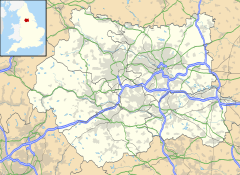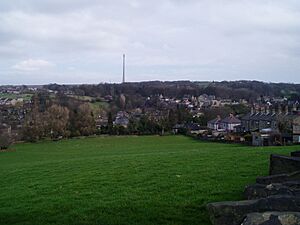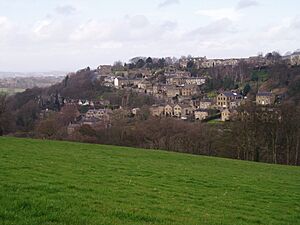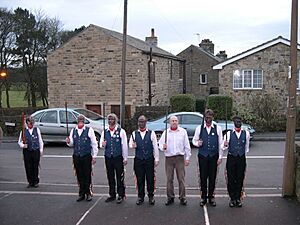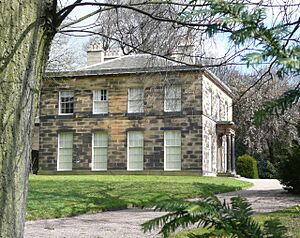Kirkburton facts for kids
Quick facts for kids Kirkburton |
|
|---|---|
 All Hallows' Churchyard |
|
| Population | 4,299 (2011 census) |
| OS grid reference | SE1912 |
| Civil parish |
|
| Metropolitan borough | |
| Metropolitan county | |
| Region | |
| Country | England |
| Sovereign state | United Kingdom |
| Post town | HUDDERSFIELD |
| Postcode district | HD8 |
| Dialling code | 01484 |
| Police | West Yorkshire |
| Fire | West Yorkshire |
| Ambulance | Yorkshire |
| EU Parliament | Yorkshire and the Humber |
| UK Parliament |
|
Kirkburton is a village in West Yorkshire, England. It is about 5 kilometers (3 miles) south-east of Huddersfield. Long ago, it was part of the West Riding of Yorkshire. The area includes the villages of Kirkburton and Highburton, plus smaller areas like Thunder Bridge and Storthes Hall. In 2011, the village itself had about 4,299 people living there.
Contents
A Look Back: Kirkburton's History
People lived in this area even in the Iron Age, thousands of years ago. It's thought that an early settlement was built where the church now stands. A Saxon fort might also have been there.
The village is mentioned in the Domesday Book from 1086. This was a big survey ordered by William the Conqueror. The book called it 'Bertone' and said it was mostly empty land back then.
After the Normans took over England, the village started to grow. Kirkburton got its name after the church was built in 1190. Highburton was built on a nearby hill. In the Middle Ages, the area was part of a larger region called the Manor of Wakefield. Kirkburton's church was the main church for a huge area.
During the First English Civil War (1642-1651), most villagers supported the Parliament. But the local priest, Gamaliel Whitaker, was on the King's side. Soldiers came to arrest him in 1644, and his wife, Hester, was accidentally shot. People say her ghost still haunts the old vicarage!
The number of people living here grew a lot because of the textile industry. By 1800, there were about 1,400 residents. Sixty years later, this number was almost 3,700. After that, the population went down for a while. But in recent years, with new houses built in Highburton, the population is now closer to 5,000.
A railway line came to Kirkburton in 1867. It was mainly used for moving goods, but passengers could also travel until 1930. The railway closed completely in 1965. You can still see parts of the old railway route and a bricked-up tunnel today.
A large hospital for mental health was located at Storthes Hall from 1904 to 1991. After it closed, the land was sold to the University of Huddersfield. Now, it's mostly a student village with homes for university students.
Kirkburton's main jobs used to be in the wool industry and coal mining. Today, the village has a small shopping area. Highburton has become more of a place where people live.
Kirkburton's Industries
Making woollen cloth was a big deal here even during the time of Queen Elizabeth I. It grew very fast after the late 1700s. The first factory, called a textile mill, opened around 1787. It used water power to prepare wool. Around 1800, another mill opened that used steam power. These mills grew into large businesses. By 1880, there were eight mills working in the area.
Making leather (called tanning) and digging for coal were also important jobs for many years. The last leather factory closed in the 1830s. Coal mining became more important as steam engines needed coal. By 1850, there were 20 small coal mines here. You can still see signs of old mines today. The last coal mine closed about 70 years ago. Another old industry was making tools like shovels, but that factory moved away a few years ago.
In 2006, a company called Shepley Spring Ltd started a bottled water factory in Kirkburton. They use the good quality underground water sources in the area. This factory makes millions of bottles of water for supermarkets.
How Kirkburton is Governed
Kirkburton used to be part of the West Riding of Yorkshire. In 1894, Kirkburton became an "Urban District." This meant it had its own local government. In 1938, it grew bigger by adding nearby villages.
In 1974, the Urban District was ended. Kirkburton then became part of Kirklees, a larger local government area. Today, Kirkburton is a "civil parish." This means it has a local council that looks after the village and other places nearby. In 2011, the civil parish had a population of 26,439 people.
Sports in Kirkburton
Kirkburton AFC is a local football team that plays at the Gregory Playing Fields. There's also a Kirkburton Junior Football Club for younger players. The Stafflex Arena is in the village. It used to be where Huddersfield Town trained. Now, other football clubs play there.
Kirkburton Cricket Club started in 1860. They play at a place called Riley. Famous English cricketer Phillip DeFreitas played for the club in 1995.
The Gregory Fields Tennis Club was built in 2000 with help from the lottery. It has three tennis courts with lights for playing at night.
More About Kirkburton
Kirkburton has two schools: Kirkburton First School and Kirkburton Middle School. The village also has a special building for Freemasons, several pubs, a health center, a dentist, and a police station. The main road through the village is North Road and George Street, where most of the shops are.
Kirkburton and Highburton have a community group that meets at the Burton Village Hall.
Kirkburton is famous for its rapier dance team. They perform traditional longsword dances every New Year's Day at local pubs. This tradition was brought back in 1974 after stopping for many years. The dancers wear clogs, blue waistcoats, and trousers with ribbons. For their New Year performances, they also blacken their faces.
The Kirkburton Uniformed Group is a community group for young people. It's linked to the All Hallows Church and has almost 100 young members, including Scouts and Guides.
Places of Worship
Kirkburton Church is called All Hallows' Church. It was built in 1190 and is a very old and important building. Most of it is from the 1200s, and the tower was added in the 1400s. Inside, you can see an old wooden ceiling, a large pulpit, and old pews. There's also a very old stone cross from the 900s, which suggests an even older church might have been here. The church and its churchyard have been carefully looked after and the churchyard is now a wildlife sanctuary.
The Salvation Army started a group in the village in 1885. Their building opened in 1964. The Salvation Army left in 2005, and the building is now used by a charity called the Denby Dale Centre.
The Methodist Chapel was built in 1816 but moved to North Road in 1845. It closed in 1987 and is now a private home. Another Methodist chapel, the Primitive Methodist Chapel, was built in Highburton in 1832. It closed in 1973 and is also now a private house.
Interesting Places to See
The Masonic Hall is a building built in 1889 in a mock-Tudor style. It's where the local Freemasons group meets.
The George Inn is the oldest pub in the village, built in the 1700s. It's on George Street, near the old blacksmith's. In 1777, important meetings happened here to plan a new road. The Royal Hotel, a stone pub built in 1870, was once the second largest pub. It has now been changed into a Co-operative shop.
Springfield Mill dates back to about 1820. The owners built Springfield House in the 1830s. This house was bought by the local council in 1935 and became the town hall. It was sold in 1982 and is now known as Kirkburton Hall. It's a protected historic building.
The Foxglove pub was built in 1868. It was first called the Railway Junction because people hoped Kirkburton would become a big railway hub. This never happened. It was known as the Three Owls until 2000, when it got its current name. An extension was added in 2001, which is now the hotel part of the building.
Manor Mill at Linfit was one of three old corn mills in the area. It dates from about 1832 and used to have one of the biggest water wheels in the country. The wheel was removed during Second World War to be used for scrap metal.
Recently, archaeologists found an amazing old iron-working site at Myers Wood. This site was used from the 1100s to the 1300s. Workers there used advanced methods and water power to make iron.


